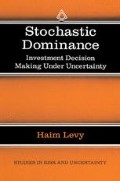Abstract
In judging the quality of an investment decision making rule, two factors have to be taken into account: a) its underlying assumptions; b) its effectiveness in terms of the relative size of the resultant efficient set. Based solely on the first factor, the FSD is the best rule because the only assumption needed for its derivation is that U ∈ U1 or U′ ≥ 0. However, the FSD rule is likely to be ineffective in that the resultant efficient set may not be much smaller than the feasible set. Generally, the larger the number of assumptions (e.g., risk aversion, decreasing absolute risk aversion), the smaller the induced efficient set.
Access this chapter
Tax calculation will be finalised at checkout
Purchases are for personal use only
Preview
Unable to display preview. Download preview PDF.
Notes
Levy, H., and Hanoch, G., “Relative Effectiveness of Efficiency Criteria for Portfolio Selection,” Journal of Financial and Quantitative Analysis,” Vol. 5, 1970, pp. 63–76.
Hadar, J. and Russell, W.R., “Rules for Ordering Uncertain Prospects,” American Economic Review, Vol. 59, 1969, pp. 25–34.
Hanoch, G. and Levy, H., “The Efficiency Analysis of Choices Involving Risk,” Review of Economic Studies, Vol. 36, 1969, pp. 335–46.
Levy, H., and Sarnat, M, “Alternative Efficiency Criteria: An Empirical Analysis,” Journal of Finance, Vol. 25, 1970, pp. 1153–58.
Porter, R.B., and Gaumnitz, J.E., “Stochastic Dominance vs. Mean Variance Portfolio Analysis: An Empirical Evaluation,” American Economic Review, Vol. 62, 1972, pp. 438–46.
Porter, R.B., “An Empirical Comparison of Stochastic Dominance and Mean-Variance Choice Criteria,” Journal of Financial and Quantitative Analysis, Vol. 8, 1973, pp. 587–608.
Porter, R.B., “Semi-variance and Stochastic Dominance: A Comparison,” American Economic Review, Vol. 64, 1974, pp. 200–204.
Joy, O.M., and Porter, R.B., “Stochastic Dominance and Mutual Fund Performance,” Journal of Financial and Quantitative Analysis, Vol. 9, 1974, pp. 25–31.
Vickson, R.G., and Altman, M., “On the Relative Effectiveness of Stochastic Dominance Rules: Extension to Decreasingly Risk-Averse Utility Functions,” Journal of Financial and Quantitative Analysis, Vol. 12, 1977, pp. 73–84.
Kroll, Y., and Levy, H., “Stochastic Dominance with a Riskless Asset: An Imperfect Market,” Journal of Financial and Quantitative Analysis, Vol. 14, June 1979, pp. 179–204.
Levy, H., and Sarnat, M., “Investment Performance in an Imperfect Securities Market,” Financial Analyst Journal, Vol. 28, 1972, pp. 78–81.
Tehranian, H., “Empirical Studies in Portfolio Performance Using Higher Degrees of Stochastic Dominance,” Journal of Finance, 35, March 1980, pp. 159–171.
Okuney, J., “A Comparative Study of the Gini’s Mean Difference and Mean Variance in Portfolio Analysis,” Accounting and Finance, 28, 1988, pp. 1–15.
Fishburn, P.S., Decision and Value Theory, New York: Wiley, 1964.
Meyer, J., “Choices Among Distributions,” Journal of Economic Theory, 11, 1977, pp. 119–132.
Meyer, J., “Second Degree Stochastic Dominance with Respect to a Function,” International Economic Review, 18, 1979, pp. 477–487.
Bawa, V.S., J. Bondurtha, M.R., Rao and H.L. Suri, “On Determination of Stochastic Dominance Optimal Set,” Journal of Finance, 40, 1985, pp. 417–431.
Deshpande, J.V. and H. Singh, “Testing for Second Order Stochastic Dominance,” Comm. Statist., Part A: Theory and Methods, 14, 1985, pp. 887–897.
Eubank, R., Schechtman, E., and Yitzhaki, S., “A Test for Second Order Stochastic Dominance,” Commun. Statist. — Theory Math., 22(7), 1993, pp. 1893–1905.
Dickinson, J.P., “The Reliability of Estimation Procedures in Portfolio Analysis,” Journal of Financial and Quantitative Analysis, Vol. 9, 1974, pp. 447–62.
Johnson, K.H., and Burgess, R.C., “The Effects of Sample Sizes on the Accuracy of EV and SD Efficiency Criteria,” Journal of Financial and Quantitative Analysis, 10, December 1975, pp. 813–820.
Levy, H., and Kroll, Y., “Stochastic Dominance: A Review and Some New Evidence,” Research in Finance, Vol. 2, 1980, pp. 163–227.
Levy, H., and Kroll, Y., “Sampling Errors and Portfolio Efficiency Analysis,” Journal of Financial and Quantitative Analysis, 15, No. 3, September 1980, pp. 655–688.
Author information
Authors and Affiliations
Rights and permissions
Copyright information
© 1998 Springer Science+Business Media New York
About this chapter
Cite this chapter
Levy, H. (1998). The Empirical Studies. In: Stochastic Dominance. Studies in Risk and Uncertainty, vol 12. Springer, Boston, MA. https://doi.org/10.1007/978-1-4757-2840-8_7
Download citation
DOI: https://doi.org/10.1007/978-1-4757-2840-8_7
Publisher Name: Springer, Boston, MA
Print ISBN: 978-1-4757-2842-2
Online ISBN: 978-1-4757-2840-8
eBook Packages: Springer Book Archive

